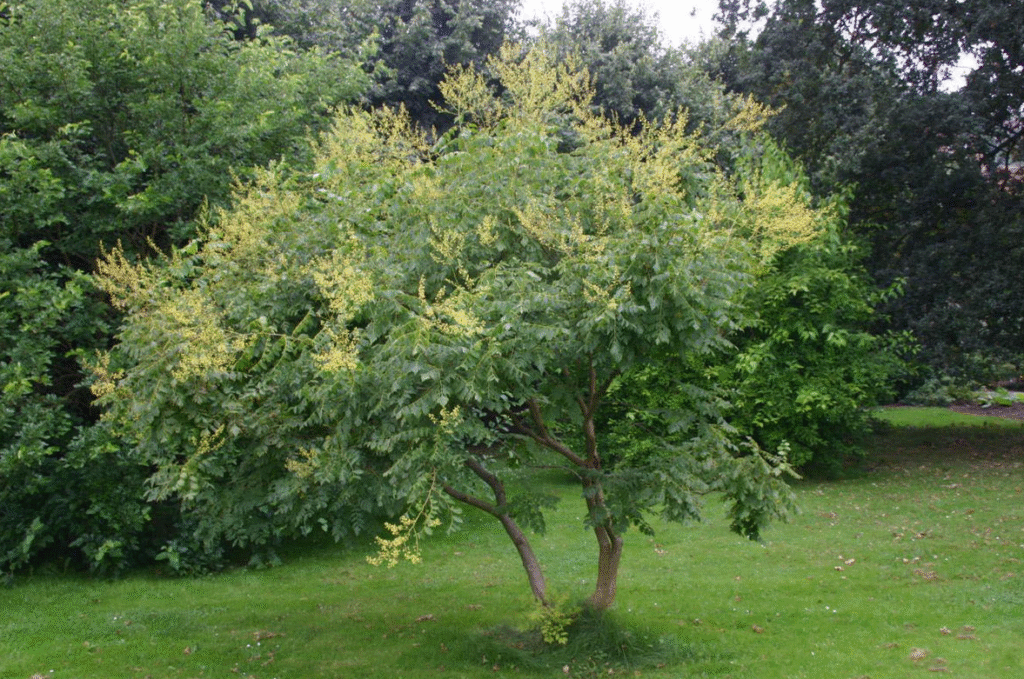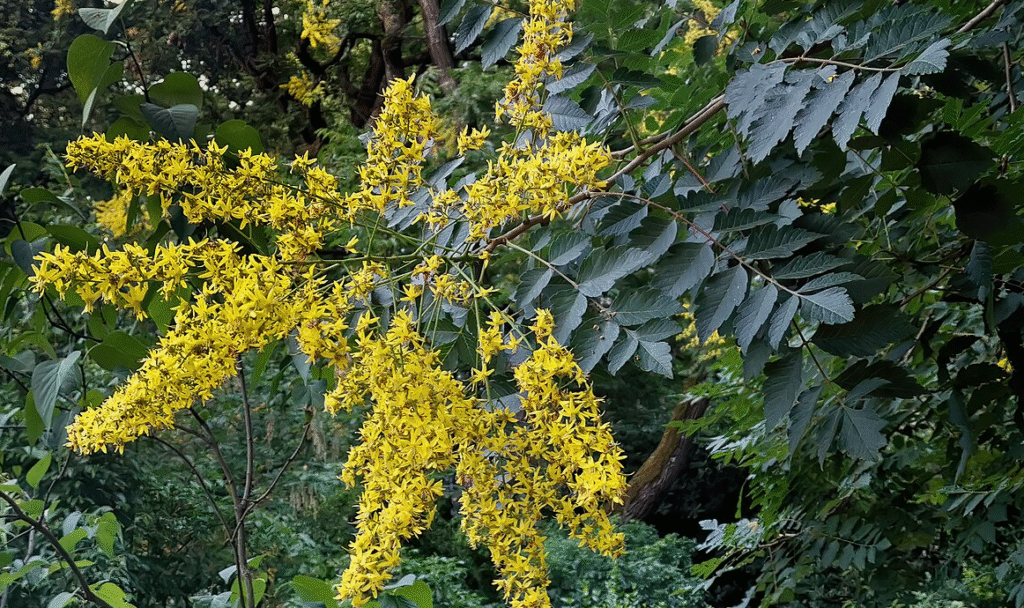
Botanical classification
The Golden Rain Tree, scientifically known as Koelreuteria paniculata, is a deciduous ornamental tree in the Sapindaceae family, which also includes maples and lychees. Its botanical classification places it within the genus Koelreuteria, named after German botanist Joseph Gottlieb Koelreuter, with paniculata referring to its clustered flower panicles.
This species is valued for its vibrant floral displays and adaptability, making it a popular choice in landscaping despite its relatively modest size. It shares familial traits like compound leaves and tolerance for varied conditions, aligning it with other Sapindaceae members known for ornamental qualities.
Native area and distribution
Native to eastern Asia, primarily China, Korea, and Japan, Koelreuteria paniculata thrives in temperate regions with well-drained soils, often found in open woodlands, hillsides, and disturbed areas. Its natural distribution spans warm, temperate climates, but it has been widely cultivated beyond its native range, particularly in North America, Europe, and Australia.
Introduced to Western gardens in the 18th century, it gained popularity for its striking summer blooms and ornamental seed pods, becoming a staple in urban and suburban landscapes by the 19th century due to its tolerance of diverse environmental conditions.
History
Historically, the Golden Rain Tree was valued in its native regions for both ornamental and practical uses. In China, its wood was occasionally used for small crafts, and its seeds were employed in traditional practices, though it was primarily grown for aesthetic purposes.
Its introduction to Europe around 1747, and later to North America, was driven by its ornamental appeal, with early horticulturists noting its ability to thrive in urban settings. By the 20th century, cultivars like ‘Fastigiata’ (upright form) and ‘September’ (late-blooming) were developed to enhance its landscape versatility, cementing its status as a reliable ornamental tree.
USDA Zones
The Golden Rain Tree is hardy in USDA Zones 5b to 9a, tolerating temperatures as low as -20°F (-29°C), making it suitable for much of the United States, parts of Canada, and similar temperate regions worldwide. It prefers full sun to maximize flowering and foliage vibrancy but can tolerate light shade.
The tree thrives in a wide range of soils, from loamy to sandy, with a pH range of 5.0 to 7.5, and is notably drought-tolerant once established. Its adaptability to urban conditions, including pollution and compacted soils, makes it a favorite for city plantings, though it may struggle in poorly drained or overly wet environments.
Identifying Characteristics

Koelreuteria paniculata typically grows 20-40 feet tall and wide, with a rounded to vase-shaped canopy and an open, spreading habit. Its leaves are pinnately compound, 6-18 inches long, with 7-15 serrated leaflets, emerging bronze or reddish in spring, turning dark green in summer, and yellow to orange in fall.
The tree’s most striking feature is its large, terminal panicles (8-14 inches long) of small, bright yellow flowers, blooming in mid to late summer (June-August), creating a vibrant display. These give way to papery, lantern-like seed pods, 1-2 inches long, transitioning from green to pinkish-bronze, persisting into fall and adding ornamental interest.
The bark is smooth, light gray to brown, becoming slightly furrowed with age, and the twigs are reddish-brown with prominent lenticels. While the tree is generally pest-resistant, its seeds are mildly toxic if ingested, and the litter from flowers and pods may require cleanup in formal settings.
Landscape Uses
Specimen Plant:
- Serves as a striking focal point in lawns or gardens due to its vibrant yellow summer blooms, colorful fall foliage, and decorative seed pods.
- Moderate size (20-40 feet tall and wide) fits well in small to medium landscapes, courtyards, or urban parks.
Street and Urban Plantings:
- Tolerates urban conditions, including air pollution, compacted soils, and heat, making it ideal for city streets, medians, or parking lot islands.
- Provides shade and seasonal color in urban settings without overwhelming space constraints.
Shade Tree:
- Rounded to vase-shaped canopy offers moderate shade for patios, seating areas, or pedestrian pathways.
- Open structure allows light filtration, suitable for underplanting with low-growing perennials or groundcovers.
Mixed Borders and Groupings:
- Combines well in mixed plantings with shrubs like spirea, viburnum, or evergreens for textural contrast.
- Yellow flowers and bronze seed pods complement plants with purple or red foliage, such as smokebush or Japanese maple.
Seasonal Interest:
- Spring: Bronze to reddish new leaves; Summer: Bright yellow flower panicles; Fall: Yellow-orange foliage and papery seed pods; Winter: Attractive branching structure.
- Pods persist into fall, adding unique texture for extended visual appeal.
Ornamental Accents:
- Papery seed pods used in dried floral arrangements or crafts, enhancing indoor decor.
- Attracts bees and butterflies during bloom season, supporting pollinator-friendly gardens.
Small Space Gardens:
- Compact cultivars like ‘Fastigiata’ (columnar form) suit narrow spaces, courtyards, or containers.
- Manageable size prevents overcrowding in residential landscapes or tight urban plots.
Challenges:
- Flower and pod litter may require cleanup in formal settings or high-traffic areas.
- Avoid planting near patios or walkways if litter is a concern.
Cultivation of Golden Rain Tree
Site Requirements:
- Light: Full sun (6+ hours daily) for optimal flowering and foliage color; tolerates light shade but may reduce blooms.
- Soil: Adapts to a wide range of soils (loamy, sandy, clay), prefers well-drained, pH 5.0-7.5; tolerates poor, infertile soils.
- Hardiness: USDA Zones 5b-9a, withstands temperatures to -20°F (-29°C).
Planting:
- Plant in spring or early fall to allow root establishment before extreme heat or cold.
- Space 20-30 feet apart to accommodate mature spread; dig a hole twice as wide and as deep as the root ball.
- Apply 2-3 inches of organic mulch (e.g., bark or wood chips), keeping it 2 inches from the trunk to prevent rot.
Watering:
- Water deeply once or twice weekly during the first 1-2 years to establish roots; reduce to occasional watering once established.
- Highly drought-tolerant but benefits from supplemental water during prolonged dry spells, especially in sandy soils.
- Avoid waterlogged conditions to prevent root rot.
Fertilization:
- Minimal needs; apply a balanced, slow-release fertilizer (e.g., 10-10-10) in early spring if growth is slow or soil is very poor.
- Avoid over-fertilizing, as excessive nitrogen can reduce flowering and encourage weak growth.
Pruning:
- Prune in late winter or early spring before new growth to maintain shape, remove dead/damaged branches, or thin crowded areas.
- Minimal pruning needed; focus on shaping young trees to a single leader for tree form or multiple stems for shrub-like appearance.
- Remove suckers or low branches to enhance canopy structure; disinfect tools to prevent disease spread.
Pests and Diseases:
- Generally pest-resistant; occasional issues include aphids, scale, or spider mites, treatable with insecticidal soap or horticultural oil.
- Susceptible to verticillium wilt or root rot in poorly drained soils; ensure proper drainage and avoid overwatering.
- Monitor for leaf spot or powdery mildew in humid conditions; improve air circulation through pruning if needed.
Propagation:
- Seeds: Collect pods in fall, extract seeds, and sow in spring after scarification; germination is slow (30-60 days) and variable.
- Cuttings: Take 4-6 inch softwood cuttings in early summer, treat with rooting hormone, and plant in a well-draining mix; keep moist and warm.
- Layering: Possible but less common; encourage low branches to root in soil for new plants.
Maintenance Tips:
- Rake up fallen flowers and pods in formal settings to maintain tidiness.
- Inspect for weak or crossing branches during pruning to improve structure and longevity.
- Tolerates urban pollution, drought, and heat, making it low-maintenance once established.
Challenges:
- Seeds are mildly toxic if ingested; avoid planting in areas accessible to children or pets.
- Weak wood may break in high winds; stake young trees and select sheltered sites in windy regions.
- Invasive potential in some areas (e.g., parts of the southeastern U.S.); check local regulations before planting.